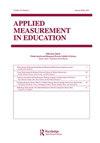阅读理解测试项目的反应需求——项目难度建模研究综述
IF 1.1
4区 教育学
Q3 EDUCATION & EDUCATIONAL RESEARCH
引用次数: 1
摘要
项目难度建模研究包括:(a)假设项目特征或项目反应需求,这些特征或需求可能在一定程度上准确地预测项目难度;(b)将特征作为自变量输入回归方程或其他统计模型中以预测难度。在这篇综述中,我们报告了13项阅读理解测试的实证项目难度模型研究的结果。我们将阅读理解项目的响应需求定义为阅读段落变量(例如,长度、复杂性)、逐条变量(例如,项目与文本之间的对应程度、所要求的信息类型)以及项目词干和响应选项变量。我们报告了与项目难度相关的反应需求变量,并说明了如何使用它们以与构建相关的方式来管理项目难度,以便经验项目难度在目标范围内(例如,在测试的IRT量表上位于精通或其他熟练程度范围内)。本文章由计算机程序翻译,如有差异,请以英文原文为准。
Response Demands of Reading Comprehension Test Items: A Review of Item Difficulty Modeling Studies
ABSTRACT Item difficulty modeling studies involve (a) hypothesizing item features, or item response demands, that are likely to predict item difficulty with some degree of accuracy; and (b) entering the features as independent variables into a regression equation or other statistical model to predict difficulty. In this review, we report findings from 13 empirical item difficulty modeling studies of reading comprehension tests. We define reading comprehension item response demands as reading passage variables (e.g., length, complexity), passage-by-item variables (e.g., degree of correspondence between item and text, type of information requested), and item stem and response option variables. We report on response demand variables that are related to item difficulty and illustrate how they can be used to manage item difficulty in construct-relevant ways so that empirical item difficulties are within a targeted range (e.g., located within the Proficient or other proficiency level range on a test’s IRT scale, where intended).
求助全文
通过发布文献求助,成功后即可免费获取论文全文。
去求助
来源期刊

Applied Measurement in Education
Multiple-
CiteScore
2.50
自引率
13.30%
发文量
14
期刊介绍:
Because interaction between the domains of research and application is critical to the evaluation and improvement of new educational measurement practices, Applied Measurement in Education" prime objective is to improve communication between academicians and practitioners. To help bridge the gap between theory and practice, articles in this journal describe original research studies, innovative strategies for solving educational measurement problems, and integrative reviews of current approaches to contemporary measurement issues. Peer Review Policy: All review papers in this journal have undergone editorial screening and peer review.
 求助内容:
求助内容: 应助结果提醒方式:
应助结果提醒方式:


